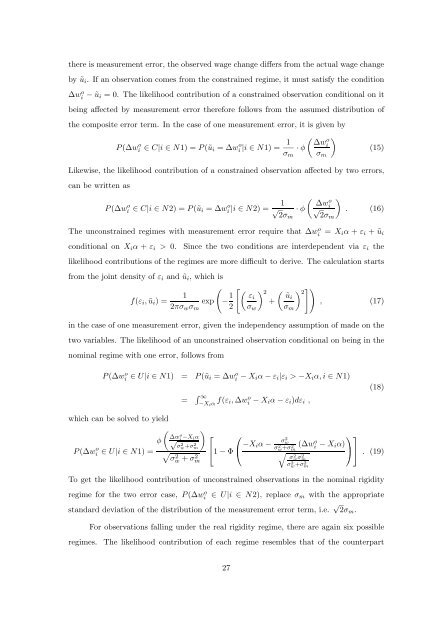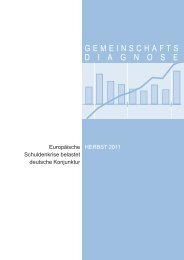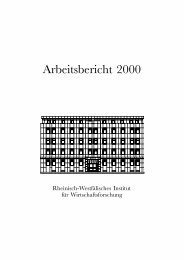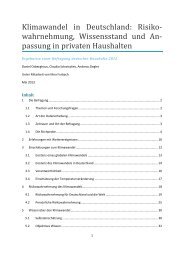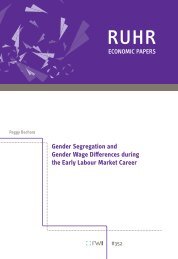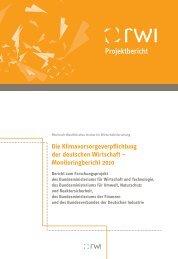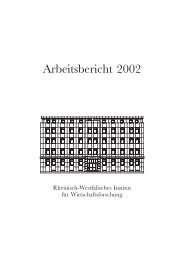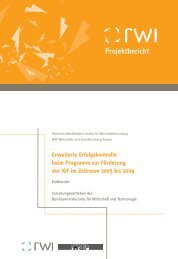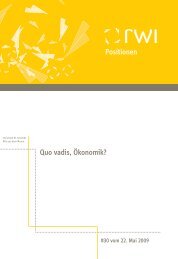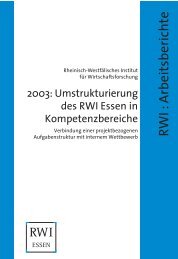RW I:Discussion Papers - Rheinisch-Westfälisches Institut für ...
RW I:Discussion Papers - Rheinisch-Westfälisches Institut für ...
RW I:Discussion Papers - Rheinisch-Westfälisches Institut für ...
You also want an ePaper? Increase the reach of your titles
YUMPU automatically turns print PDFs into web optimized ePapers that Google loves.
there is measurement error, the observed wage change differs from the actual wage change<br />
by ũ i . If an observation comes from the constrained regime, it must satisfy the condition<br />
∆wi o − ũ i = 0. The likelihood contribution of a constrained observation conditional on it<br />
being affected by measurement error therefore follows from the assumed distribution of<br />
the composite error term. In the case of one measurement error, it is given by<br />
P (∆wi o ∈ C|i ∈ N1) = P (ũ i =∆wi o |i ∈ N1) = 1 ( ) ∆w<br />
o<br />
· φ i<br />
σ m σ m<br />
(15)<br />
Likewise, the likelihood contribution of a constrained observation affected by two errors,<br />
can be written as<br />
P (∆wi o ∈ C|i ∈ N2) = P (ũ i =∆wi o |i ∈ N2) = √ 1 ( ) ∆w<br />
o<br />
· φ i √2σm . (16)<br />
2σm<br />
The unconstrained regimes with measurement error require that ∆w o i<br />
= X i α + ε i +ũ i<br />
conditional on X i α + ε i > 0. Since the two conditions are interdependent via ε i the<br />
likelihood contributions of the regimes are more difficult to derive. The calculation starts<br />
from the joint density of ε i and ũ i ,whichis<br />
( [ (<br />
1<br />
f(ε i , ũ i )= exp − 1 ) 2 ( ) ]) 2 εi ũi<br />
+<br />
, (17)<br />
2πσ w σ m 2 σ w σ m<br />
in the case of one measurement error, given the independency assumption of made on the<br />
two variables. The likelihood of an unconstrained observation conditional on being in the<br />
nominal regime with one error, follows from<br />
P (∆w o i ∈ U|i ∈ N1) = P (ũ i =∆w o i − X iα − ε i |ε i > −X i α, i ∈ N1)<br />
= ∫ ∞<br />
−X iα f(ε i, ∆w o i − X iα − ε i )dε i ,<br />
(18)<br />
which can be solved to yield<br />
( )<br />
∆wi φ<br />
o−Xiα<br />
⎡ ⎛<br />
√<br />
P (∆wi o σ 2 w +σm<br />
∈ U|i ∈ N1) = √ 2 ⎣1 − Φ ⎝ −X iα −<br />
σ 2 w + σm<br />
2<br />
σ2 w<br />
σw 2 +σ2 m<br />
√<br />
σ 2 w σm<br />
2<br />
σw+σ 2 m<br />
2<br />
⎞⎤<br />
(∆wi o − X iα)<br />
⎠⎦ . (19)<br />
To get the likelihood contribution of unconstrained observations in the nominal rigidity<br />
regime for the two error case, P (∆wi<br />
o ∈ U|i ∈ N2), replace σ m with the appropriate<br />
standard deviation of the distribution of the measurement error term, i.e. √ 2σ m .<br />
For observations falling under the real rigidity regime, there are again six possible<br />
regimes.<br />
The likelihood contribution of each regime resembles that of the counterpart<br />
27


